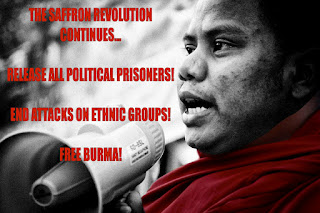Monk Leaders Call for Third Sangha Boycott
By ARKAR MOE Tuesday, August 25, 2009
By ARKAR MOE Tuesday, August 25, 2009
Several exiled Buddhist
monk leaders have told The Irrawaddy that Burmese monks across Burma are preparing
to launch another boycott of military personnel and their families due to
ongoing abuses against Buddhist principles by the ruling military junta.
Known as a
“pattanikkujjana” in Pali, a Buddhist monks’ boycott involves refusing morning
alms from those said to have violated religious principles.
A Burmese monk living
in Thailand speaks outside the UN office during a rally calling for Aung San
Suu Kyi’s release in Bangkok in May. (Photo: Reuters)
Burmese monks have declared a pattanikkujjana against the military regime and their cronies twice in recent history: the first time in 1990 following the suppression of Aung San Suu Kyi and her opposition party, the National League for Democracy, after they had won a national election by a landslide; and again in 2007, the so-called “Saffron Revolution,” when monks led demonstrations against price hikes in Rangoon that turned into a national uprising against the government.
Burmese monks have declared a pattanikkujjana against the military regime and their cronies twice in recent history: the first time in 1990 following the suppression of Aung San Suu Kyi and her opposition party, the National League for Democracy, after they had won a national election by a landslide; and again in 2007, the so-called “Saffron Revolution,” when monks led demonstrations against price hikes in Rangoon that turned into a national uprising against the government.
Burma’s monasteries,
some housing as many as 1,000 practicing monks, have been largely silent since
the junta ordered a crackdown on the monk-led protests in August and September
2007. But several sources say that the simmering resentment could come to a
head again in the lead-up to the regime’s election planned for 2010.
A monk in Rangoon who
asked to remain anonymous told The Irrawaddy on Tuesday: “The local authorities
are closely watching the monks and their monasteries. Moreover, there are
plainclothes security forces keeping an eye on them.”
The military
authorities closed and sealed Maggin monastery in Rangoon’s Thingankyun
Township in November 2007 after its abbot, Sayadaw U Indaka, was arrested for
his involvement in the demonstrations. The monks and novices were evicted along
with several HIV/ AIDS patients who were receiving treatment in the monastery
at the time.
Speaking to The
Irrawaddy, Ashin Issariya, one of the leaders of the exiled All Burma Monks’
Alliance (ABMA), said, “I want to call for all people and organizations to take
part in a third monks’ boycott for the sake of peace and the welfare of all
Burmese people.
“The Lord Buddha said
that the sangha (Buddhist monkhood) had to carry out their religious duties by
sacrificing their lives.
“Therefore, all members
of the sangha must act to protect the Buddhist religion and the welfare of our
people,” he said.
Currently, Burma’s
Ministry of Religious Affairs is effectively controlling and curtailing the
nations’ Buddhist monks under an order by the Sangha Maha Nayaka Committee (the
state- sponsored Buddhist monks’ organization), which restricts monks’ travel
and gatherings.
Ashin Issariya said
that the junta’s troops and loyalists had committed many religious crimes, such
as beheading Buddha images, raiding and destroying monasteries, and killing and
arresting monks and nuns.
He added that there is
no freedom of religion under the military junta and that all religions are
affected.
“Therefore, if the
military authorities do not apologize for their abuses and crimes, it is the
responsibility of all monks, nuns and laypersons to boycott the junta,” he
said.
Some activists in Burma
told The Irrawaddy that currently many monks’ organizations and monasteries are
trying to organize themselves and set up cooperation and communication with
monks’ groups other parts of the country.
Ashin Thavara, a
secretary of the India-based All Burma Monks’ Representative Committee (ABMRC),
told The Irrawaddy: “Nowadays, the ABMRC is cooperating with the ABMA to not
only carry out our religious duties, but to help the people and achieve peace
in Burma and throughout the world.
“It is high time that
all the people of Burma and around the world take action and boycott Burma’s
military dictators,” he said.
Ashin Thavara said that
during the September uprising, the junta’s soldiers and loyalist thugs had raided
and destroyed more than 60 monasteries, and beat, arrested and killed several
hundred monks and nuns. He claimed that there are currently more than 250 monks
and more than 20 nuns in prison in Burma for their political activities.
“Some of them were sentenced
to hard labor,” he added. “Others were sent with military battalions to work as
porters at the front lines of the battlefields.”
During the 2007 Saffron
Revolution, monks enacted a boycott of military families and cronies by
overturning their alms bowls to refuse alms, an act of defiance that marked the
uprising.
According to official
data, there are more than 400,000 monks in Burma, and its community, the
sangha, is considered one of the strongest and most revered institutions in the
country. It has always played an important role in Burma’s social and political
affairs, often in opposition to oppressive regimes.
Ashin Candobhasacara,
one of the leaders of the US-based International Burmese Monks’ Organization,
told The Irrawaddy on Tuesday: “Our organization issued an announcement on
Monday to mark the second anniversary of the Saffron Movement, and we plan to
demonstrate against the Burmese junta by reciting the “Metta Sutta” (the
Buddha’s words of loving-kindness) in front of the G20 Summit in Pittsburgh and
in Union Square in New York on September 24 to 26.
“Now, all people and
all organizations need to cooperate and condemn Burma’s military dictators,” he
said. “We will encourage and support all the brave monks and demonstrators
because they are sacrificing their lives and property for religion and peace in
Burma and throughout the world.”
Copyright © 2008 Irrawaddy Publishing Group
Copyright © 2008 Irrawaddy Publishing Group










0 comments:
Post a Comment